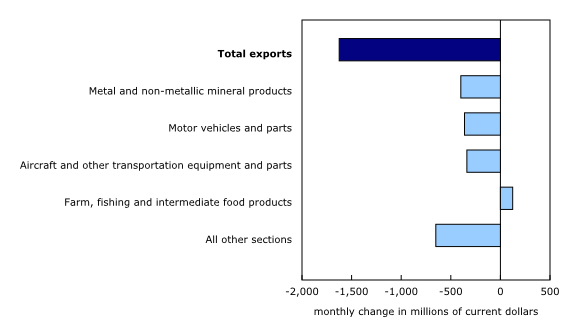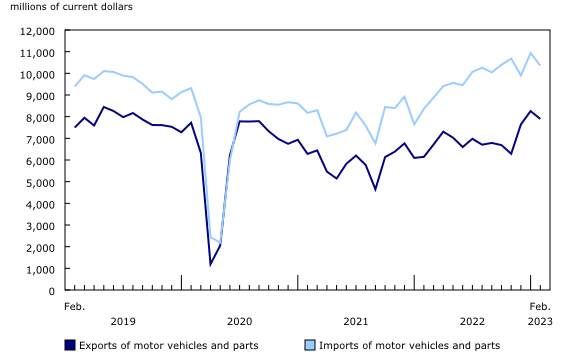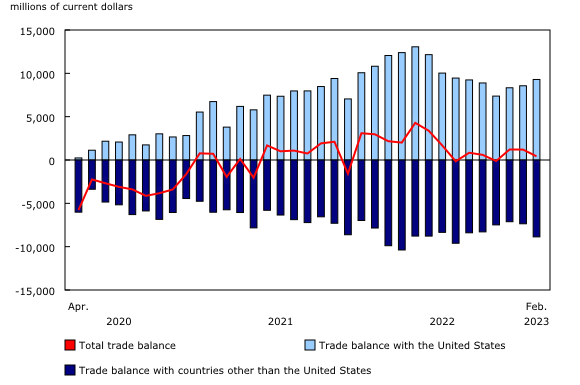Canadian international merchandise trade, February 2023
Released: 2023-04-05
Following strong increases in January, Canadian merchandise exports and imports decreased in February. Exports were down 2.4%, while imports decreased 1.3%. As a result, Canada's merchandise trade surplus with the world narrowed from $1.2 billion in January to $422 million in February. The February surplus is close to the typical bounds for monthly revisions to imports and exports.
Consult the "International trade monthly interactive dashboard" to explore the most recent results of Canada's international trade in an interactive format.
Lower exports of unwrought gold and passenger cars
After increasing 3.5% in January, total exports fell 2.4% to $65.0 billion in February. All product sections decreased except farm, fishing and intermediate food product exports (+2.1%), which rose for the fifth time in the last six months. In real (or volume) terms, total exports decreased 0.9%, following a 4.8% increase in January.
Exports of metal and non-metallic mineral products decreased 5.4% in February. After rising 17.9% in January, exports of unwrought gold, silver and platinum group metals and their alloys—a category mainly composed of unwrought gold—were down 11.5% in February. As in January, refined gold exports to the United Kingdom contributed the most to the monthly change. Exports of unwrought nickel and nickel alloys (-20.0%) also contributed to the decline in this product section in February, largely due to lower exports to Norway.
After reaching their highest level since May 2019, exports of motor vehicles and parts fell 4.4% to $7.9 billion in February 2023. Exports of passenger cars and light trucks (-7.3%) led the decrease in this product section. Monthly variations in the number of motor vehicles manufactured in Canada in January and February 2023 were the opposite of the monthly change observed for the same months in 2022, resulting in strong variations in exports on a seasonally adjusted basis for the first two months of 2023. However, when exports of passenger cars and light trucks in January and February are combined, they show an increase of almost 36% in 2023 compared with the same two months in 2022. While supply chain issues appear to be easing, they remain a significant factor in the export movements observed in recent months.
In February 2023, exports of aircraft and other transportation equipment and parts fell 14.9% to $1.9 billion, the lowest value observed since April 2022. Exports of aircraft (-52.9%) saw the biggest decline, mostly due to lower exports of private jets and commercial aircraft.
Imports of industrial machinery and passenger cars decline
After increasing 3.6% in January, total imports fell 1.3% to $64.6 billion in February. Despite the monthly decrease, import values remain higher than the November and December 2022 levels, when declines were also observed. In February 2023, 8 of the 11 product sections fell. In real (or volume) terms, total imports were down 0.8%.
Imports of industrial machinery, equipment and parts decreased 8.7% in February. This decline follows a record high for these imports in January. In February, lower imports in the "other industry-specific manufacturing machinery" product group were responsible for the decrease. Since the beginning of 2022, imports in this category have shown significant monthly variations, mainly due to imports of modules and parts for the new liquefied natural gas terminal project under construction in British Columbia. Since high-value deliveries for this project do not occur every month, they cause month-to-month changes in the import values for this product section.
After rising 10.5% to a record level in January, imports of motor vehicles and parts were down 5.3% in February. Imports of engines and parts (-5.4%) and of passenger cars and light trucks (-3.8%) were mostly responsible for the monthly decrease. Lower imports of engines and parts reflected a slowdown in motor vehicle production in February in Canada following an increase in January. Despite the monthly decline for passenger cars and light trucks, import levels were more than 34% higher compared with February 2022.
Imports of consumer goods rose 6.9% in February, partly offsetting the overall decrease in imports. Higher imports of pharmaceutical products (+35.0%) were behind almost all of the increase. Large quantities of drugs unrelated to COVID-19 were imported from Ireland in February. Excluding pharmaceutical products, imports of consumer goods increased 1.0% in February.
After posting a record high in January, exports to countries other than the United States decline in February
Exports to countries other than the United States decreased 7.2% in February, following a 6.3% increase in January. Lower exports to the United Kingdom (gold), India (miscellaneous products) and Iraq (aircraft and wheat) were partly offset by higher exports to Hong Kong (miscellaneous products) and China (agricultural products and coal).
Imports from countries other than the United States rose 1.3% in February. A sharp increase in imports from Ireland (pharmaceutical products) was largely offset by the decline in imports from Switzerland (pharmaceutical products and nickel), Belgium (pharmaceutical products) and Italy (other industry-specific manufacturing machinery).
Canada's merchandise trade deficit with countries other than the United States widened from $7.4 billion in January to $8.9 billion in February.
Exports to the United States fell 0.9% in February, while imports decreased 2.8%. As a result, Canada's trade surplus with the United States widened from $8.6 billion in January to $9.3 billion in February. This was the third consecutive monthly increase in the trade surplus with the United States.
Revisions to January merchandise export and import data
Imports in January, originally reported at $65.1 billion in the previous release, were revised to $65.5 billion in the current reference month. Exports in January, originally reported at $67.0 billion in the previous release, were revised to $66.7 billion in the current reference month's release.
Monthly trade in services
In February, monthly service exports were down 1.3% to $14.0 billion. Meanwhile, service imports increased 0.4% to $16.2 billion.
When international trade in goods and services were combined, exports decreased 2.2% to $79.0 billion in February, while imports were down 1.0% to $80.8 billion. As a result, Canada's trade deficit with the world went from $766 million in January to $1.8 billion in February.
Note to readers
Merchandise trade is one component of Canada's international balance of payments (BOP), which also includes trade in services, investment income, current transfers, and capital and financial flows.
International trade data by commodity are available on both a BOP and a customs basis. International trade data by country are available on a customs basis for all countries and on a BOP basis for Canada's 27 principal trading partners (PTPs). The list of PTPs is based on their annual share of total merchandise trade—imports and exports—with Canada in 2012. BOP data are derived from customs data by adjusting for factors such as valuation, coverage, timing, and residency. These adjustments are made to conform to the concepts and definitions of the Canadian System of National Accounts.
For a conceptual analysis of BOP-based data versus customs-based data, see "Balance of Payments trade in goods at Statistics Canada: Expanding geographic detail to 27 principal trading partners."
For more information on these and other macroeconomic concepts, see the Methodological Guide: Canadian System of Macroeconomic Accounts (13-607-X) and the User Guide: Canadian System of Macroeconomic Accounts (13-606-G).
The data in this release are on a BOP basis and are seasonally adjusted. Unless otherwise stated, values are expressed in nominal terms, or current dollars. References to prices are based on aggregate Paasche (current-weighted) price indexes (2012=100). Movements within aggregate Paasche prices can be influenced by changes in the share of values traded for specific goods, with sudden shifts in trading patterns—as observed with the COVID-19 pandemic—sometimes resulting in large movements in Paasche price indexes. Volumes, or constant dollars, are calculated using the Laspeyres formula (2012=100), unless otherwise stated.
For information on seasonal adjustment, see Seasonally adjusted data – Frequently asked questions.
Revisions
In general, merchandise trade data are revised on an ongoing basis for each month of the current year. Current-year revisions are reflected in both the customs-based and the BOP-based data.
The previous year's customs-based data are revised with the release of data for the January and February reference months, and thereafter on a quarterly basis. The previous two years of customs-based data are revised annually, and revisions are released in February with the December reference month.
The previous year's BOP-based data are revised with the release of data for the January, February, March and April reference months. To remain consistent with the Canadian System of Macroeconomic Accounts, revisions to BOP-based data for previous years are released annually in December with the October reference month.
Factors influencing revisions include the late receipt of import and export documentation, incorrect information on customs forms, the replacement of estimates produced for the energy section with actual figures, changes in merchandise classification based on more current information, and changes to seasonal adjustment factors. The seasonal adjustment parameters are reviewed and updated annually and applied with the October reference month release.
For information on data revisions for exports of energy products, see Methodology for Exports of Energy Products within the International Merchandise Trade Program.
Revised data are available in the appropriate tables.
Real-time data table
The real-time data table 12-10-0120-01 will be updated on April 17.
Next release
Data on Canadian international merchandise trade for March will be released on May 4.
Products
The product "International trade monthly interactive dashboard" (71-607-X) is now available. This new interactive dashboard is a comprehensive analytical tool that presents monthly changes in Canada's international merchandise trade data on a balance-of-payments basis, fully supporting the information presented every month in the Daily release.
The product "The International Trade Explorer" (71-607-X) is now available online.
The Canadian International Merchandise Trade online database is no longer available. It has been replaced by the Canadian International Merchandise Trade Web Application (71-607-X), a modern tool that provides trade data users with a number of enhancements.
The updated "Canada and the World Statistics Hub" (13-609-X) is now available online. This product illustrates the nature and extent of Canada's economic and financial relationship with the world using interactive charts and tables. It provides easy access to information on trade, investment, employment and travel between Canada and a number of countries, including the United States, the United Kingdom, Mexico, China, Japan, Belgium, Italy, the Netherlands and Spain.
Contact information
For more information, or to enquire about the concepts, methods or data quality of this release, contact us (toll-free 1-800-263-1136; 514-283-8300; infostats@statcan.gc.ca) or Media Relations (statcan.mediahotline-ligneinfomedias.statcan@statcan.gc.ca).
- Date modified:








